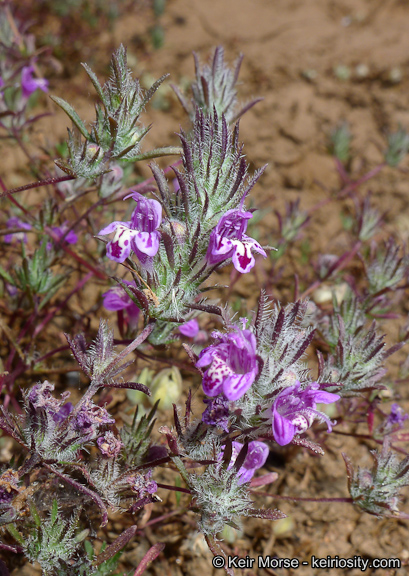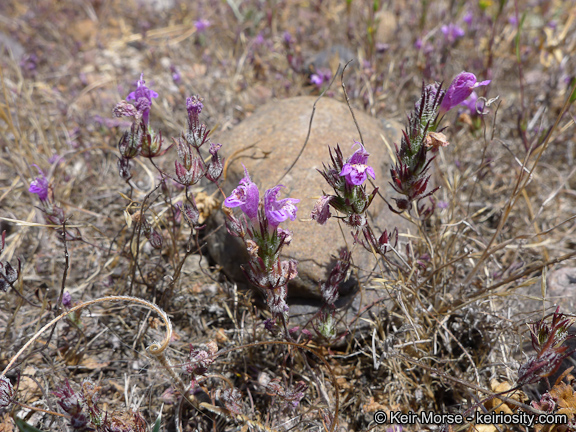
San Diego Mesa Mint
Pogogyne abramsii
Pogogyne abramsii

San Diego Mesa Mint
Pogogyne abramsii
Pogogyne abramsii
| Historically present | |
| Between 2000 and | |
| Last 10 years |
Goal: Protect, enhance, and restore vernal pool habitat on Conserved Lands in the MSPA that supports or has the potential to support VF and SL species (i.e., California Orcutt grass, Otay mesa mint, San Diego button-celery, San Diego mesa mint, spreading navarretia, Riverside fairy shrimp, San Diego fairy shrimp, and western spadefoot) so that the vegetation community has high ecological integrity, and these species are resilient to environmental stochasticity and threats, such as altered hydrology, climate change and invasive plants, and will be likely to persist over the long term (>100 years).
Management units: 6
Beginning in 2018, conduct annual surveys for San Diego mesa mint in occupied, historically occupied and potentially suitable vernal pools to determine cover clases in each basin and cover of each nonnative species using a standardize protocol as defined in the VPMMP (City of San Diego 2015). Nonnative cover classes will be combined to determine if management triggers for Level 1, 2 or 3 management are met. Management recommendations will be made, noting individual nonnative species that pose a threat to direct specific management actions. Management actions will be implemented annually as part of the general vernal pool habitat management objectives for different management levels (ML1, ML2, ML3).
| Action | Statement | Action status | Projects |
|---|---|---|---|
| IMP-1 | Submit project metadata, monitoring datasets and management recommendations to the MSP Web Portal. | On hold |
| Criteria | Deadline year |
|---|---|
| Annual Surveys Completed with Management Recommendations | 2021 |
| Threat Name | Threat Code |
|---|---|
| Altered hydrology | ALTHYD |
| Climate change | CLICHN |
| Human uses of the Preserves | HUMUSE |
| Invasive plants | INVPLA |
| Urban development | URBDEV |
| File name | Lead Author | Year | Type |
|---|---|---|---|
| County of San Diego MSCP Monitoring Summary Report January 1998 - June 2007 | County of San Diego | 2007 | report |
| MSP Roadmap Dec 31, 2016: VF Species and Vegetation Goals, Objectives, and Actions | San Diego Management and Monitoring Program | 2016 | other |
| Revised Final City of San Diego Vernal Pool Habitat Conservation Plan Management and Monitoring Plan | 2020 | report | |
| Summary Results of Rare Plant Field Monitoring City of San Diego MSCP | 2009 | fact sheet | |
| Vernal Pool Management and Monitoring 2019 | Berninger, Mark | 2019 | powerpoint presentation |
California and San Diego endemic restricted to vernal pools on mesas of western San Diego County, CA [1]. Confusion exists regarding the historical range.
Within MSPA it is found in MU2: Kearny Mesa, at Montgomery-Gibbs Executive Airport (Mongomery Field), Murphy Canyon, Marine Corps Air Station Miramar which supports the majority of occurrences, MU6: Del Mar Mesa, Carroll Canyon, Lopez Ridge/Peñasquitos Canyon, City of Mira Mesa [2].
FE/CE [3].
Found exclusively in vernal pools with Redding soils and a clay subsoil perched on a hardpan [4]. Found 90-200 m in elevation [1]. San Diego Mesa mint is considered an obligate wetland species (found almost always in wetland areas), but is more tolerant of the seasonal inundation of vernal pool habitats [5].
Mint family (Lamiaceae) [6]. One of 8 recognized species of Pogogyne [4]. John Thomas Howell (1931) separated Pogogyne nudiscula into two species: P. nudiscula and P. abrasmii based on hairs on the calyx, thinner bracts, and geographic distribution [7]. He considered populations north of Mission Valley P.abramsii and all populations on Otay Mesa P. nudiscula. Current work supports this separation and distinction based on the above characteristics and a different number of flowers per node [6].
An annual herb with flowers arranged in whorls [8]. The plants usually give off a strong, sweet mint odor [9]. Stems thread like, wiry-erect to spreading 5-20cm, generally 0.5- 0.8 mm diameter at inflorescence base; bracts are purple-tinged with acuminate tips; inflorescence 8-10 mm wide; calyx densely white-hairy; bell shaped corolla 10–12 mm, sparsely hairy; style hairy 2-4 mm below stigma lobes. Fruit ± 1.5 mm [6].
Blooms from May or June through early July when water is absent from the vernal pool completing its life cycle in the spring rather than in the summer through winter months [5, 9]. The sparsely hairy, small bell-shaped purple flowers have a yellow or white throat and diagnostic hairy style [4]. It has two flowers per node on the stem [6]. Vegetation gives off a reddish tinge as plant matures [8]. The link between the onset of germination, the temporal conditions needed for vernal pool inundation, temperature, and moisture are critical to the germination, maturation, flowering, and fruiting [2].
The Eurasian honey bee (Apis mellifera) and two anthophorid bees (Exomalopsis nitens and E. torticornis) are the most common and likely pollinators of P. abramsii [10]. Potential pollinators in nearby chaparral were also found visiting vernal pool flora [11]. Self-fertile, but greater seed set when cross-pollinated [10]. Seeds float, which may result in dispersal opportunities when pools interconnect [12]. Waterfowl visit pools and are presumed to dispersal agents [13]. Small animal movement may be a potential vector for seed dispersal and gene flow between vernal pool obligate species [14].
Threatened by OHV use, military activities, alteration of watershed, habitat fragmentation and isolation of vernal pool systems and complexes, degradation due to filling, grading, discing, and leveling, invasion from weedy nonnative plants, human access and disturbance, trampling, small population size, soil compaction, erosion, drought and climate change, and fire control activities [15]. Destruction of watersheds and disruption of hydrological systems can create further impacts by creating barriers to dispersal, such that pollination and reproductive output may be inhibited [11,12].
Examination of occurrence data from the time of listing suggests that the distribution of Pogogyne abramsii has decreased since its listing in 1978 [5]. Rainfall and temperature both affect the germination rate and successful reproduction [12]. Soil moisture late in the season is probably as important as is actual duration of standing water for this species therefore drought may play an important role in restricting the species to pool basins where soils are saturated longer and retain water in the spring [15]. Modifications to the uplands associated with a vernal pool complex can impact the pool’s hydrology, even if they occur outside the pool’s surface area [4].
[1] California Native Plant Society Rare Plant Program. 2016. Inventory of Rare and Endangered Plants (online edition, v8-02). California Native Plant Society, Sacramento, CA. Available: http://www.rareplants.cnps.org. Accessed November 8, 2016.
[2] MSP-MOM. 2014. Management Strategic Plan Master Occurrence Matrix. San Diego, CA. Available: http://sdmmp.com/reports_and_products/Reports_Products_MainPage.aspx
[3] U.S. Fish and Wildlife Service. 1978. Endangered and Threatened WIldlife and Plants: Endangered and threatened wildlife and plants: Final Rule; Determination of Endangered Status for Five Plants as Endangered Species. Federal Register 43: 44810.
[4] U.S. Fish and Wildlife Service. 1998. Vernal Pools of Southern California Recovery Plan. Portland, OR.
[5] U.S. Fish and Wildlife Service. 2010. Pogogyne abramsii San Diego Mesa Mint 5-Year Review: Summary and Evaluation. Carlsbad, CA.
[6] Silveira, M., M.G. Simpson, and J.D. Jokerst. 2016. Â Pogogyne nudiuscula, in Jepson Flora Project (eds.)Â Jepson eFlora. Available: http://ucjeps.berkeley.edu/cgi-bin/get_IJM.pl?tid=38938. Accessed on December 20, 2016.
[7] Howell, J. T. 1931. The Genus Pogogyne. Proceedings of the California Academy of Sciences 20: 105–128.
[8] Jokerst, J.D. 1993. The Jepson Manual: Higher Plants of California, Pogogyne In J.C. Hickman (editor), Berkeley: University of California Press.
[9] Munz, P.A. 1974. A Flora of Southern California. Berkeley: University of California Press.
[10] Schiller, J. R., P. H. Zedier, and C. H. Black. 2000. The Effect of Density Dependent Insect Visits, Flowering Phenology, and Plant Size on Seed Set of the Endangered Vernal Pool Plant Pogogyne abramsii (Lamiaceae) in Natural Compared to Created Vernal Pools. Wetlands 20: 386– 396.
[11] Scioli, J.A. 2014. Pollinator Specificity and Pollen Limitation in the San Diego Mesa Mint, Pogogyne abramsii, A Vernal Pool Endemic. University of California, San Diego.
[12] Schleidlinger, C.R. 1981. Population Dynamics of Pogogyne abramsii on the Clairemont Mesa, San Diego County, California. M.S. Thesis, San Diego State University, San Diego California.
[13] Zedler, P.H. 1987. The Ecology of Southern California Vernal Pools: A Community Profile. Biological Report 85 (7.11). U.S. Fish and Wildlife Service, Washington, DC.
[14] Zedler, P.H. and C. Black. 1992. Seed Dispersal by a Generalized Herbivore: Rabbits as Dispersal Vectors in a Semiarid California Vernal Pool Landscape. American Midland Naturalist 128:1– 10.
[15] Bauder, E.T. 1987. Threats to San Diego Vernal Pools and Case Study in Altered Pool Hydrology, ed. T.S. Elias, 209-213, Conservation and Management of Rare and Endangered Plants. Proceedings from a conference of the California Native Plant Society.